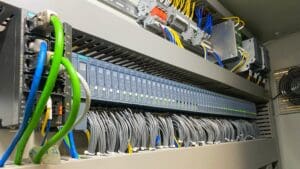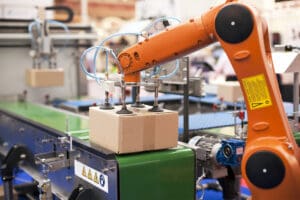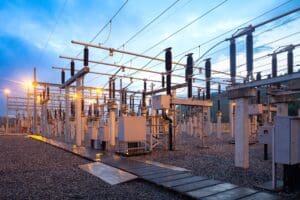Throughout the 21st century there have been many advancements in industrial settings towards greater automation capabilities. Technologies like robotics have played a significant role in driving these changes, with the US Robotics market projected to reach more than $50bn in 2025 and the global Robotic Process Automation (RPA) market expected to be valued at $81.8bn by 2032. The continued adoption of Artificial Intelligence (AI) models and cloud-based infrastructure have also supported increased automation in industrial settings. Robotic Process Automation (RPA) market expected to be valued at $81.8bn by 2032. The continued adoption of Artificial Intelligence (AI) models and cloud-based infrastructure have also supported increased automation in industrial settings.
As end user systems change, it’s important that power supplies evolve alongside them to allow for safe and efficient use. Any potential cost-savings created by the automation system will be negated if it cannot function reliably.
This article contains important information about the design features of power supplies for industrial automation systems. We discuss the various types of automation used in industrial settings, the key features of effective industrial automation system power supplies, and what the future may hold for this relationship.
Examples of modern industrial automation systems
Automation has far-reaching applications, especially where core processes are repeatable, precise, or dangerous. It’s no surprise that industrial manufacturing has come to be one of the top sectors to utilize automation systems. Below you’ll find examples of the automation systems commonly used by the industrial sector in the US.
Programmable Logic Controllers (PLC)
A PLC works by receiving input data, processing it, and then delivering pre-programmed outputs. For instance, a PLC response might be triggered by changes in temperature or system current. Due to their ruggedized nature, controllers are effective at automating specific industrial processes, individual machine functions, and even entire production lines.

Power supplies must be able to provide uninterruptible power on demand to support PLC functions. There are also All-In-One PLCs which make use of Human Machine Interface (HMI) panels.
CNC machines
Computer numerical control (CNC) machines are automated tools controlled by reprogrammable computer software. This enables control over the precise movement of machinery, which can then be replicated numerous times for key processes. This makes CNC machines a common piece of equipment in industrial manufacturing.
The exact power requirements of a CNC machine will depend on its outfitting and the tooling application. For instance, the current rating in an industrial CNC machine power supply will be based on its motor ratings.
Distributed Control System (DCS)
A DCS is a device used to monitor and control industrial processes. These systems are commonly used in batch processes, where sensors collect data about the machines to ensure optimal functionality. They are also particularly important in hazardous settings, such as power plants and fuel refineries.
The power supply for an industrial DCS should be reliable so that the system can continue monitoring key processes from start to finish. Any disruption to the power supply could risk a drop in overall operational efficiency and potential damage to machinery.
Internet of Things (IoT)
The industrial internet of things (IIoT) refers to the various systems, devices, connected equipment, and sensors that monitor and analyze industrial operations data. This infrastructure is necessary to identify and troubleshoot issues as they develop. Utilizing IIoT is often an easy decision for industrial companies because it has the potential to:
- Ensure regulatory compliance
- Protect workers
- Increase productivity
- Execute predictive maintenance
- Correct inefficiencies
Industrial robotics
One of the most revolutionary developments in manufacturing automation has been the introduction of industrial robotics. Articulated robotic arms and Selective Compliance Assembly Robot Arms (SCARAs) are among the most common, although there are a massive variety of robots which can be used depending on the industrial setting. For instance, small automated vehicles might assist with sorting in warehouses.

When it comes to powering industrial robotics, power supplies must be efficient and quick to start up. Designs must also be compact and lightweight to account for any constraints in the robotic system.
Key Developments in American industrial automation
Looking back just 50 years, many of the systems discussed above didn’t exist or hadn’t even been conceived of yet. However, the principles of process efficiency and safety have remained at the heart of automation to this day. The difference is that over time, technology has enabled us to harness greater amounts of power and channel it into automating precision processes.
While the first and second industrial revolutions established automation within industrial settings, digital automation as we know it only started to develop around the beginning of the 20th century. Here, the first data processing computers were created, along with key industrial automation infrastructure, such as electrical substations.

The term ‘automation’ started to emerge in 1947, when Ford created their automation department to help assemble vehicles. In the years that followed, many factories incorporated solid-state digital logic modules to enable automation and more effective process monitoring. Another notable development was the introduction of microprocessors to allow computers to control and execute complex tasks.
Industry 4.0 (2014)
The term ‘Industry 4.0’ is used to refer to the fourth industrial revolution. This is characterized by new concepts and technologies, used primarily by the industrial and manufacturing sectors, that form an integrated approach to projects and processes. Modern industrial automation systems typically fall into one the following categories:
- Cloud computing
- Autonomous robotics
- Augmented reality
- Industrial Internet of Things (IIoT)
- AI and machine learning
- Cybersecurity
- Digital twin simulations
- Horizontal and vertical integrations
Although these technologies are the pillars of Industry 4.0, the timeline of innovation is far from over. At the time of writing, we are still in the midst of this industrial revolution with much more scope for new developments.
Power supply design considerations for automated industrial systems
When designing power supplies for utilization by industrial automation systems, the priority should be on delivering stable and reliable power that meets the requirements of the overall system. To this end, the power supply should contain components and features that maintain consistent functionality.
Voltage regulation
Circuits must create and maintain a fixed output voltage regardless of any changes to load conditions or input voltage. Incorporating voltage regulators into the design helps maintain a consistent voltage range. It is important to determine the voltage and current requirements of the end user system and whether or not the automation system requires multiple output channels.
If an unregulated power supply is used, it can risk ripple voltages and voltage fluctuations which can cause damage to delicate components in automation systems. This should be avoided as damage to microprocessors, I/O modules, or memory chips can be extremely expensive to repair.
Short-Circuit Protection (SCP)
To avoid potentially dangerous rapid current surges, SCP is a common feature in many industrial power supplies. In the event of an abnormality such as a low-resistance path, this feature automatically shuts down the power supply. This is important to prevent excessive current flow which might cause overheating, equipment damage, or safety risks. The automation power supply might incorporate fuses, circuit breakers, and resettable fuses to provide short-circuit protection.

There are several types of Over Current Protection (OCP). The power supply could shut down upon reaching an over current situation but this may be undesirable in cases where there are motor start currents or capacitive load currents which temporarily exceed the OCP point. In these cases, a power limit where the current continues to be available as the voltage falls may be in order. Conversely a delay on OCP before inception of the protection may be warranted. There could also be a hiccup mode where the supply see’s an over current, shuts down and then restarts. If the over current is still present it shuts down again and continues this loop until the over current is removed.
Ruggedization
Automation system power supplies must have suitable levels of ruggedness to allow them to operate in hazardous locations. Many industrial environments contain flammable gases, dust, material offcuts, and other particulates. To combat this, the power supply should be designed in accordance with IP-65 standards.
Vibration may be an issue that has to be dealt with. There are many ways we design for vibration in power supplies.
Although the environment itself should be temperature controlled, power supplies for automation systems must be designed to handle a wide range of temperatures. Many of the DC DC and AC DC power supplies offered by Wall Industries operate within a -40°C to +85°C temperature range, but wider temperature range models are available for more extreme circumstances.
Electromagnetic Interference (EMI) filters
Power supplies intended for use in industrial automation systems must contain EMI filters to ensure they do not interfere with nearby electronics. Relevant certifications for American manufacturers include the IEC 62368 and IEC 60601, as well as IECEE SMT and EN61000 standards.
Soft-start circuits
For applications with delicate components, soft-start circuits ensure a gradual increase in output voltage. This reduces initial inrush current to help prevent damage to internal components.
How to choose power supplies for industrial automation systems
When it comes to selecting the best power supply for industrial automation systems, there are several factors that need to be considered. This includes:
- Input Voltage. Automation systems will have different input voltage range requirements which must be met by the power supply. It is usually best to choose a power supply that has a wider input voltage range than required to compensate for any temporary spikes in power demand.
- Power Efficiency. The more efficient a power supply, the less energy it will use and the less heat it will generate. This not only saves on running costs, but also helps delay component degradation and reduces risk of failure.
- Current requirements. Automation systems typically contain a range of different components, each with its own draw. As such, you should try to determine the total voltage and current requirements of the system when choosing appropriate industrial power supply products.
- Mounting. Choose a power supply that can physically fit within the system without causing issues.
- Safety and Compliance. Check that your power supply meets all the requirements and relevant certifications.
- Redundancy. If you’re sourcing a power supply for a critical process, it might be worth it to fit a second power supply in parallel. This redundant power supply acts as a failsafe in the event that the other stops working or loses efficiency.
- Noise. Depending on the system application, a low noise power supply can be beneficial for working conditions and to help minimize risk of component interference.
- Budget. It’s important to consider budget restrictions as different power supplies will have different features, intended uses, and prices.
Looking to the future of industrial automation
It’s relatively common now for entire factories and industrial facilities to be fully automated, with staff available only to complete maintenance work and input command updates. Given the rapid pace of automation technology advances in the 21st century, it’s important that power supply designers are able to integrate with new systems. Upcoming developments and trends in this space include:
- Industry 5.0 – This refers to the next industrial revolution, which will see robots and smart machines working alongside people towards sustainability goals. Although the European Union has taken the first steps in recognizing Industry 5.0, with the Industry 5.0 Community of Practice created in November 2023, the US is following along in projects and initiatives regarding the Industry 5.0 framework.
- Rise of integrated automation and robotics – in the coming years, it seems probable that we’ll see an increase in IT and software integration systems, computer-aided process planning (CAPP) systems, and more. The International Federation of Robotics reported more than 4 million factory robots operating worldwide in 2024, a vast increase from the start of the century.
- Utilization of emerging technologies – while augmented reality and additive manufacturing are relatively new concepts in industrial settings, they are likely to be implemented more in business infrastructure in the future. Many businesses are looking to these technologies as a way to become more efficient, unlock new revenue streams, and get ahead of the competition.
- Custom automation solutions – certain forms of industrial manufacturing and businesses need automation solutions customized to meet their requirements. As understanding of industrial automation deepens, it can be leveraged to overcome diverse operational challenges.
- Power supply innovation – as systems such as AI push the boundaries of what is possible, power supplies must follow suit to achieve maximum efficiency. Custom power supply design might be more highly demanded to fulfill the requirements of more complex prototypes.
- Consulting and training – as automation continues to become more prevalent and diverse, there will likely be a demand for expert training and consulting services to help businesses adapt. This could include all aspects of implementation, from power supply infrastructure to safety procedures.
Experts in power supply design for industrial applications
If you’re thinking about implementing industrial automation systems, it’s important to consider the power supply requirements that come with it. Equally, if you need to source new power supplies, you need to be clear on the key features for effectiveness.
Wall Industries has the engineering expertise to provide custom power supply solutions for use with industrial automation systems. Being at the forefront of industrial innovation allows us to craft power supplies for use in the most advanced automation systems, meeting power, size, safety, and industry-specific requirements.
We have a wide range of industrial grade power supplies designed for optimal performance across various industrial environments. All our products are vetted for performance and efficiency by our experienced team.
Contact us to discuss how we can help make your industrial automation systems a reality.
